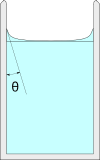I've been banging my head against this all day long, without getting to a real final answer, but I did get some progress...
Across the air-liquid boundary there is a pressure difference given by the Young-Laplace Equation:
$$\Delta p = 2 \gamma K_m,$$
where $K_m$ is the mean curvature of the surface. Assuming the interface is a surface of revolution, $z = z(x)$, with $x$ the radial coordinate, the mean curvature comes out to be:
$$K_m = -\frac{1}{2\sqrt{1+z'^2}}(\frac{z'}{x}+\frac{z''}{1+z'^2}).$$
This is of course highly intractable, so you usually hope for the slope $z'$ to be small, so that $z'^2$ is negligible, so that you can get away with the much simpler approximation
$$K_m \approx -\frac{1}{2}(\frac{z'}{x}+z'').$$
On the air side of the free surface, you have the constant atmospheric pressure, $p_0$, while on the other side there will be a hydrostatic pressure distribution, $p_1-\rho g z$, so
$$\Delta p = p_1 - p_0 -\rho g z.$$
Overall the shape of the free surface is governed by the equation
$$z'' + \frac{z'}{x} -\frac{1}{\lambda^2} z= \frac{p_0 - p_1}{\gamma},$$
where $\lambda = \gamma / \rho g$ is the capillary length. Now, taking the capillary length as the unit of distance, the above simplifies to
$$z'' + \frac{z'}{x} - z= \frac{p_0 - p_1}{\rho g}.$$
If the sign on the $z$ above where a plus, the above could be converted, choosing a suitable origin for z, into a Bessel equation of order $0$, but I am pretty sure the sign is correct, so no luck there.
But if you look at an actual glass of water filled to the brim, you will see that most of the bending of the surface happens close to the border, while the central region is mostly flat. So if $z'$ is only large when $x$ is much larger, the last equation simplifies to
$$z'' - z= \frac{p_0 - p_1}{\rho g},$$
and if the central portion is perfectly flat, then there will be no pressure difference there, an $p_1=p_0$ if the origin of $z$ is set at the level of water in the center point, so
$$z'' = z,$$
with boundary conditions $z(0) = 0$ and $z(r)=\tan \alpha$, where we still need to figure out what $\alpha$ is, more on this later.
The solution to the above equation is
$$z = \tan \alpha \frac{e^x -e^{-x}}{e^r -e^{-r}},$$
and the difference between the center point and the border is $\tan \alpha$ measured in capillary length units, or alternatively
$$\Delta h = \sqrt{\frac{\gamma }{\rho g}}\tan \alpha.$$
So what value does $\alpha$ take? In a cylindrical container, as Paul indicates, $\alpha$ is $\pi/2-\theta$, where $\theta$ is the contact angle, and the center of the glass is actually below the borders. But when you fill a glass to its rim, the rounded nature of this starts bending the outside borders of the water, eventually making $\alpha$. If we suppose contact is happening at the highest point of the rim, then $\alpha$ is the contact angle, only negative, and the center will be $\sqrt{\gamma / \rho g} \tan \theta$ above the rim.
Of course the water may go beyond the highest point of the rim, but I am not sure of how far it can go before everything becomes unstable and you get spilling...






